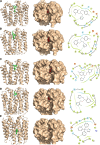Antifungal Azoles as Tetracycline Resistance Modifiers in Staphylococcus aureus
- PMID: 33990311
- PMCID: PMC8276810
- DOI: 10.1128/AEM.00155-21
Antifungal Azoles as Tetracycline Resistance Modifiers in Staphylococcus aureus
Abstract
Staphylococcus aureus has developed resistance to antimicrobials since their first use. The S. aureus major facilitator superfamily (MFS) efflux pump Tet(K) contributes to resistance to tetracyclines. The efflux pump diminishes antibiotic accumulation, and biofilm hampers the diffusion of antibiotics. None of the currently known compounds have been approved as efflux pump inhibitors (EPIs) for clinical use. In the current study, we screened clinically approved drugs for possible Tet(K) efflux pump inhibition. By performing in silico docking followed by in vitro checkerboard assays, we identified five azoles (the fungal ergosterol synthesis inhibitors) showing putative EPI-like potential with a fractional inhibitory concentration index of ≤0.5, indicating synergism. The functionality of the azoles was confirmed using ethidium bromide (EtBr) accumulation and efflux inhibition assays. In time-kill kinetics, the combination treatment with butoconazole engendered a marked increase in the bactericidal capacity of tetracycline. When assessing the off-target effects of the azoles, we observed no disruption of bacterial membrane permeability and polarization. Finally, the combination of azoles with tetracycline led to a significant eradication of preformed mature biofilms. This study demonstrates that azoles can be repurposed as putative Tet(K) EPIs and to reduce biofilm formation at clinically relevant concentrations. IMPORTANCE Staphylococcus aureus uses efflux pumps to transport antibiotics out of the cell and thus increases the dosage at which it endures antibiotics. Also, efflux pumps play a role in biofilm formation by the excretion of extracellular matrix molecules. One way to combat these pathogens may be to reduce the activity of efflux pumps and thereby increase pathogen sensitivity to existing antibiotics. We describe the in silico-based screen of clinically approved drugs that identified antifungal azoles inhibiting Tet(K), a pump that belongs to the major facilitator superfamily, and showed that these compounds bind to and block the activity of the Tet(K) pump. Azoles enhanced the susceptibility of tetracycline against S. aureus and its methicillin-resistant strains. The combination of azoles with tetracycline led to a significant reduction in preformed biofilms. Repurposing approved drugs may help solve the classical toxicity issues related to efflux pump inhibitors.
Keywords: Staphylococcus aureus; Tet(K) efflux protein; antifungal azoles; efflux pump inhibitors; repurposing.
Figures






Similar articles
-
Repurposing Approved Drugs as Fluoroquinolone Potentiators to Overcome Efflux Pump Resistance in Staphylococcus aureus.Microbiol Spectr. 2021 Dec 22;9(3):e0095121. doi: 10.1128/Spectrum.00951-21. Epub 2021 Dec 15. Microbiol Spectr. 2021. PMID: 34908453 Free PMC article.
-
Bioflavonoid Baicalein Modulates Tetracycline Resistance by Inhibiting Efflux Pump in Staphylococcus aureus.Microb Drug Resist. 2024 Sep;30(9):363-371. doi: 10.1089/mdr.2024.0099. Epub 2024 Aug 12. Microb Drug Resist. 2024. PMID: 39133125
-
Discovery of novel dihydronaphthalene-imidazole ligands as potential inhibitors of Staphylococcus aureus multidrug resistant NorA efflux pump: A combination of experimental and in silico molecular docking studies.Microb Pathog. 2024 May;190:106627. doi: 10.1016/j.micpath.2024.106627. Epub 2024 Mar 21. Microb Pathog. 2024. PMID: 38521473
-
NorA, Tet(K), MepA, and MsrA Efflux Pumps in Staphylococcus aureus, their Inhibitors and 1,8-Naphthyridine Sulfonamides.Curr Pharm Des. 2023;29(5):323-355. doi: 10.2174/1381612829666221212101501. Curr Pharm Des. 2023. PMID: 36515045 Review.
-
Inhibition of drug efflux pumps in Staphylococcus aureus: current status of potentiating existing antibiotics.Future Microbiol. 2013 Apr;8(4):491-507. doi: 10.2217/fmb.13.16. Future Microbiol. 2013. PMID: 23534361 Review.
Cited by
-
Selective Serotonin Reuptake Inhibitors: Antimicrobial Activity Against ESKAPEE Bacteria and Mechanisms of Action.Antibiotics (Basel). 2025 Jan 8;14(1):51. doi: 10.3390/antibiotics14010051. Antibiotics (Basel). 2025. PMID: 39858337 Free PMC article.
-
Evaluation of the Antibacterial Effect of Aurone-Derived Triazoles on Staphylococcus aureus.Antibiotics (Basel). 2023 Aug 26;12(9):1370. doi: 10.3390/antibiotics12091370. Antibiotics (Basel). 2023. PMID: 37760667 Free PMC article.
-
Progress in the Prevalence, Classification and Drug Resistance Mechanisms of Methicillin-Resistant Staphylococcus aureus.Infect Drug Resist. 2023 May 25;16:3271-3292. doi: 10.2147/IDR.S412308. eCollection 2023. Infect Drug Resist. 2023. PMID: 37255882 Free PMC article. Review.
-
Consumption of non-antibacterial drugs may have negative impact on Helicobacter pylori colonization in the stomach.Heliyon. 2024 Mar 4;10(5):e27327. doi: 10.1016/j.heliyon.2024.e27327. eCollection 2024 Mar 15. Heliyon. 2024. PMID: 38495192 Free PMC article.
-
Transcriptomic and Proteomic Analysis of Gardnerella vaginalis Responding to Acidic pH and Hydrogen Peroxide Stress.Microorganisms. 2023 Mar 8;11(3):695. doi: 10.3390/microorganisms11030695. Microorganisms. 2023. PMID: 36985268 Free PMC article.
References
-
- Pallin DJ, Egan DJ, Pelletier AJ, Espinola JA, Hooper DC, Camargo CA. 2008. Increased US emergency department visits for skin and soft tissue infections, and changes in antibiotic choices, during the emergence of community-associated methicillin-resistant Staphylococcus aureus. Ann Emerg Med 51:291–298. 10.1016/j.annemergmed.2007.12.004. - DOI - PubMed
Publication types
MeSH terms
Substances
LinkOut - more resources
Full Text Sources
Other Literature Sources
Medical
Molecular Biology Databases

